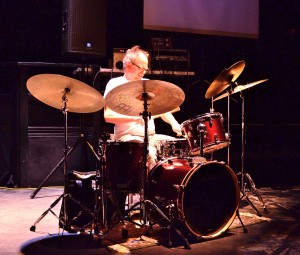Michael Bonanni, Senior Staff Writer
Fleming impresses the crowd with a solo
Last week marked the fourth annual New Music Focus Week put together by SUNY Oneonta’s music department to expose students to new and often experimental sounds in music. Tuesday night’s event featured a faculty music recital in the Hamblin Theatre, showing off some professors’ unique musical abilities. Each performance tried to explore some of the less traditional styles of music and did a great job in positively pushing attendees out of their comfort zone.
Joseph Pignato opened the show with a performance using Skype to bring in two additional band members from the other side of the world. The band consisted of Pignato on the drums, Jurica Jelic from Croatia on bass and U.K Rattay from Germany on the guitar. Triologues is the fifth piece in a series that uses social media tools in order to create art. Pignato said he chose Skype because a lot of people use it every day. “We have these profound experiences over Skype, why not make some music” he said. The music was very non-traditional, with lots of rhythmic breaks and filters making for some really interesting noises from the guitar and bass.

Geoffrey O’Shea plays his space-age music at the Hamblin
After O’Shea, drummer Blake Fleming started off his performance in a very light manner. He ran around his drum set like he was looking for something, but then he just sat down and started playing. Fleming played an improvised piece or, as he called it, “spontaneous composition.” This featured a bunch of starts and stops, but eventually Fleming found a groove and a good amount of cowbell. There were also some unique cymbals and all together the way he played created a very dramatic performance. When asked why he went with an improve piece he smiled and replied “Too lazy to compose.”
Anthony Scafide had a very interesting composition called “storytelling,” which centered on the idea that presidents convey messages that are often repeated back in their speeches. The music was electronic in nature, but featured presidential sound bites; mostly from Barack Obama. It was followed with a slide show of his experiment where Scafide saw an image of a modern day president and wrote the first thing that came to his mind. Phrases and images were often repeated since Scafide explained he had done this several times, sometimes generating different results. Many of the statements were about the moon in some way and the slide show ended in memoriam to Hugo Chavez.
Brett Masteller was up next with another electronic composition with a different array of equipment. His performance relied mostly on delays and the use of mixers, however he also added in a visual element. The screen captured his image and would react to the sounds that he was making in an amazing yet random fashion. The display was warned about beforehand for its use of flashing patterns and lights and there was plenty of that to go around. The display ranged from tie dye colors and patterns to at one point what seemed to be a yellow Fibonacci spiral. The sounds were similar to O’Shea’s except with a more staticky tone and often sounded like Masteller was playing an old school video game.
Lastly, Orlando Legname took the stage and brought with him an ensemble that included singers from the SUNY Oneonta Women’s Choir, an accordion, a brass section and electric violins. The result was really clever and also featured a video element. The music mimicked everyday settings such as a car wash and New York City. The screen had his image faded into the background as he conducted over video of the different settings. It was a metaphor for what he was actually doing, which was conducting the scene. “Dark Matter” also presented the student musicians from SUNY Oneonta with a challenge, since the sheet music they read was made using abstract pictures instead of notes. The choir provided some a cappella sound effects including the wind for the city setting while the others often mimicked city traffic. Some audio was even taken from his youngest child who couldn’t make it that night with the rest of the family.
The recital was overall a very different experience and was definitely new music. The strangeness of everything as well as the unfamiliarity made the recital very intense. It got pretty quiet between songs and acts as everyone in the room was trying to make sense of everything they heard. This was definitely an adventure into music for those looking to push the limits and discover what actually makes music what it is.
Leave a Reply